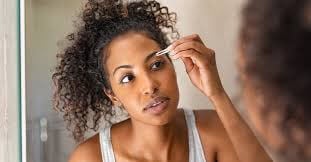
Have you ever found yourself contemplating whether to pluck or shave your facial hair? Or perhaps you're uncertain whether to remove body hair from the roots or simply trim it at the surface? It’s essential to understand which hair removal method is best suited for different parts of your body and which techniques can be safely maintained over the long term with minimal side effects.
If you’re unfamiliar with both plucking and shaving and seek detailed information before making any purchases, you’ve come to the right place. This article offers a comprehensive guide on both methods, enabling you to make an informed decision about your preferred approach by the time you finish reading.
Plucking vs Shaving
1. Definitions and Fundamentals
Plucking involves extracting hair from the roots using a tweezer, allowing for the removal of individual strands, even those that are quite short, as long as they can be grasped. The key technique here is to gently stretch the skin to make the hair more visible, facilitating a quick removal.
Conversely, shaving utilizes safety razors to cut hair at the skin's surface, effectively trimming multiple strands in a single stroke. To achieve the best results, it's crucial to use a sharp razor and to replace the blades regularly before they dull. Additionally, employing a shaving gel or cream helps protect your skin from the sharpness of the blades.

2. Facial Hair Removal
Both plucking and shaving are viable options for facial hair removal. However, plucking is generally more effective for the delicate areas of your face, as it allows for meticulous removal of stray hairs. For instance, chin hair and eyebrow hairs can be precisely shaped using tweezers.
Shaving does offer the added benefit of exfoliating dead skin cells alongside unwanted hair, particularly if you employ a dermaplaning tool with proper technique.
3. Body Hair Removal
Using tweezers to remove body hair can seem nearly impossible, given the vast number of hair strands across the body. While plucking can be effective for underarms, bikini lines, and possibly the pubic area, it would require an extensive investment of time to tweeze the rest of your body.
Shaving is significantly more practical for body hair, completing the task in about 30 minutes to an hour, making it a much more efficient option for larger areas.
4. Pain and Precision
Plucking, while precise, is often quite painful. It effectively ensures that each unwanted hair is removed, leaving no stragglers behind, but it requires considerable bravery to endure the discomfort.
Shaving, in contrast, is typically pain-free, although it is possible to miss a hair or two during the process. Areas such as eyebrows or a unibrow can be challenging to shave, as achieving symmetrical results may be difficult, and you might inadvertently remove more hair than intended.
5. Time Commitment
Plucking facial hair—such as stubble, sideburns, chin hair, and eyebrows—could take anywhere from 15 minutes to an hour, depending on the density and thickness of the hair in the specific area. On the other hand, plucking body hair can be an incredibly time-consuming endeavor, often making waxing a more efficient option for root removal.
Shaving, however, is incredibly quick, often requiring only about 10 minutes for the face and about an hour for the entire body. For further insights, you can compare trimming body hair to removing it from the roots by exploring the differences between waxing and shaving.
6. Results and Hair Regrowth
The effects of plucking can last anywhere from 4 to 6 weeks, and may extend up to 8 weeks with regular plucking. Interestingly, the regrown hair tends to be soft and fine.
In contrast, after shaving, hair can begin to resurface within just 3 days. As the hair regrows, the blunt ends created by shaving can make the hair appear thicker, and shaving does not alter the pattern of hair regrowth.
7. Required Tools
For plucking, all you need is a tweezer and an alcohol-based product to sterilize it before and after use, which helps prevent infections and ingrown hairs.
In terms of shaving, you’ll require shaving cream and a razor. The razor should be sharp and ideally new, while the cream should be gentle on the skin to avoid razor burns, cuts, and ingrown hairs. Women can explore high-quality options among hair removal razors available online.
8. Cost Considerations
Both plucking and shaving rank among the most cost-effective hair removal methods since they can be performed at home with just a single tool and a corresponding product. Typically, they range in price from $5 to $20.
The only distinction is that tweezers can last for months or even years when you invest in a quality product, while safety razors or their blades must be replaced regularly, contributing to ongoing costs.
9. Advantages
The table below outlines the benefits of plucking versus shaving, helping you determine which method may suit you best.
Plucking
Shaving
Results last for a month or more
Ideal for unibrows, upper lips, and chin hair
A single tweezer can be reused for months
Nearly painless
Time-efficient
Can be used on both the face and body, including sensitive areas.
10. Disadvantages
The following list highlights the downsides of both plucking and shaving, which may help you decide whether either method is right for you.
Plucking
Shaving
Time-intensive
Can be extremely painful
Not practical for body hair
May worsen irritated skin
Requires regular blade replacements
Hair regrows within 3 days
Can lead to ingrown hairs, cuts, and razor burns
Makes hair appear blunt and thick
What Could Be Better Than Both Methods?
If you find yourself intrigued by the advantages of both plucking and shaving, yet deterred by their drawbacks, consider a method that combines the benefits of both: IPL hair removal. One of the most efficient devices you can use for long-term results is the Ulike Air 10 IPL hair removal device.

